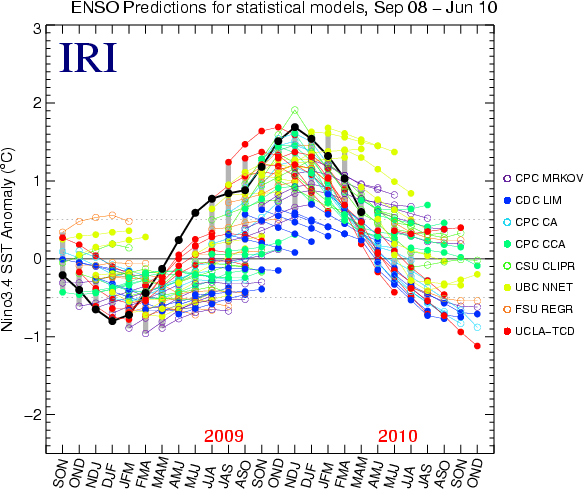
| ||||||||||||||||||||||||||||||||||||||||||||||||||||||||||||||||||||||||||||||||||||||||||||||||||||||||||||||||||||||||||||||||||||||||||||||||||||||||||||||||||||||||||||||||||||||||||||||||||||||||||||||||||||||||||||||||||||||||||||||||||||||||||||||||||||||||||||||||||||||||||||||||||||||||||||||
|
ENSO Quick Look Summary of ENSO Model Predictions16 June 2010Note on interpreting model predictionsThe following graph and table show predictions made by dynamical and statistical models for SST in the Nino 3.4 region for nine overlapping 3-month periods. Note that the expected skills of the models, based on historical performance, are not equal to one another. The skills also generally decrease as the lead time increases. Thirdly, predictions made at some times of the year generally have higher skill than predictions made at other times of the year--namely, they are better when made between June and December than when they are made between February and May. Differences among the predictions of the models reflect both differences in model design, and actual uncertainty in the prediction of the possible future SST scenario. Table 1. Predicted SST Anomalies (deg C) in the Nino 3.4 Region
Discussion of current predictionsFifty-seven percent of the set of dynamical and statistical model predictions issued during late May and early June 2010 indicate ENSO-neutral conditions during the June-August season currently in progress, while 43% predict La Nina conditions. However, for the upcoming July-September period these percentages reverse to 39% and 61%, respectively, as La Nina development becomes the more common prediction from that season through the end of 2010. There is some disagreement among models about the ENSO state during the remainder of 2010, with predictions ranging from near-neutral to strong La Nina conditions. At the time of preparing this, the SST observations in the NINO3.4 region indicate borderline La Nina conditions, with an area-averaged weekly anomaly of -0.5 C. Current predictions and observations indicate a probability of about 58% for developing La Nina conditions during the June-August period, increasing to 62% from the August-October period through the end of 2010. Probabilities for returning to El Nino are no more than 1% through the early months 2011. Summary of predictions issued over last 22 monthsThe following plots show the model predictions issued not only from the current month (as in the plot above), but also from the 21 months previous to this month. The observations are also shown up to the most recently completed 3-month period. The plots allow comparison of plumes from the previous start times, or examination of the prediction behavior of a given model over time. The first plot shows predictions for dynamical models, the second for statistical models, and the third for all models. For less difficult readability, predictions are shown to a maximum of only the first five lead times. Below the third plot, we provide a mechanism for highlighting the predictions of one model at a time against a background of more lightly colored lines for all other models. Individual Model View over last 22 monthsView individual models here. Additional information on ModelsNotes on the dataOnly models producing predictions on a monthly basis are included. This means that some models whose predictions appear in the Experimental Long-Lead Forecast Bulletin (produced by COLA) do not appear in the table. The SST anomaly predictions are for the 3-month periods shown, and are for the Nino 3.4 region (120-170W, 5N-5S). Often, the anomalies are provided directly in a graph or a table by the respective forecasting centers for the Nino 3.4 region. In some cases, however, they are given for 1-month periods, for 3-month periods that skip some of the periods in the above table, and/or only for a region (or regions) other than Nino 3.4. In these cases, the following means are used to obtain the needed anomalies for the table:
The anomalies shown are those with respect to the base period used to define the normals, which vary among the groups producing model predictions. They have not been adjusted to anomalies with respect to a common base period. Discrepancies among the climatological SST resulting from differing base periods may be as high as a quarter of a degree C in the worst cases. Forecasters are encouraged to use the standard 1971-2000 period as the base period, or a period not very different from it. | ||||||||||||||||||||||||||||||||||||||||||||||||||||||||||||||||||||||||||||||||||||||||||||||||||||||||||||||||||||||||||||||||||||||||||||||||||||||||||||||||||||||||||||||||||||||||||||||||||||||||||||||||||||||||||||||||||||||||||||||||||||||||||||||||||||||||||||||||||||||||||||||||||||||||||||||



